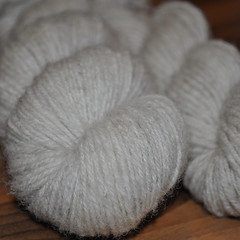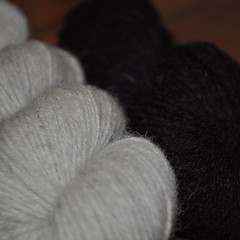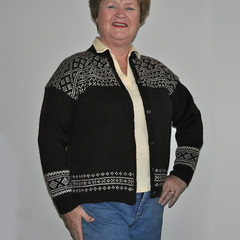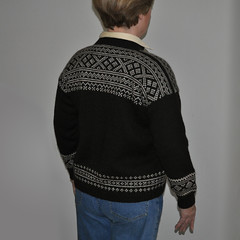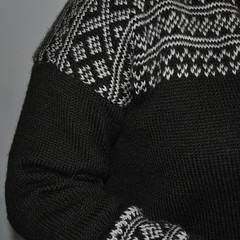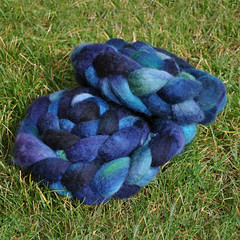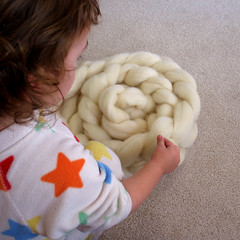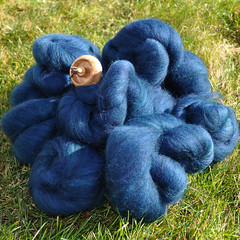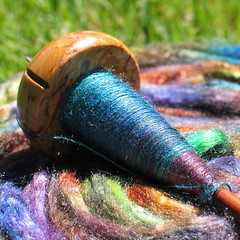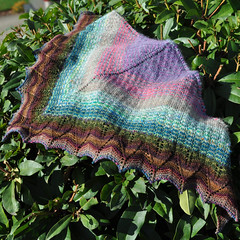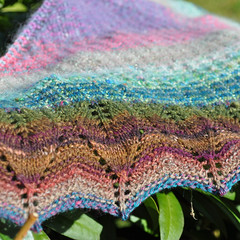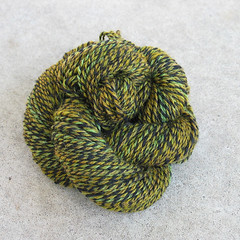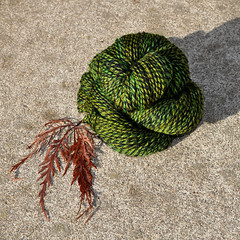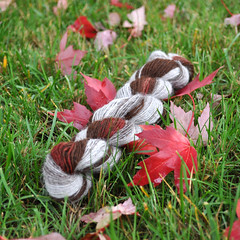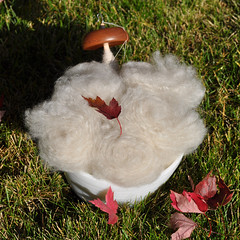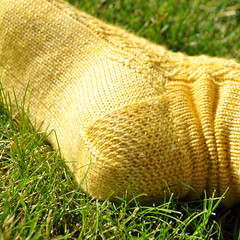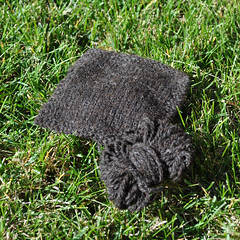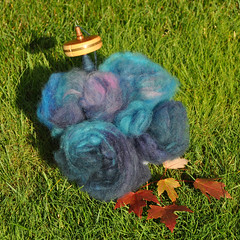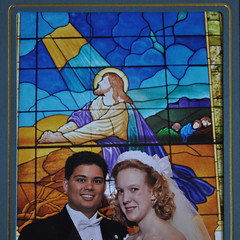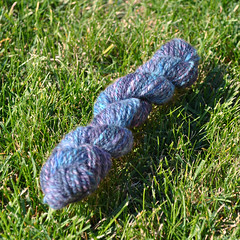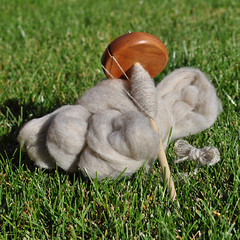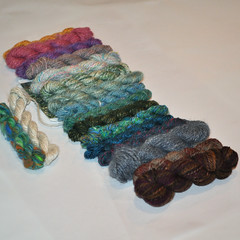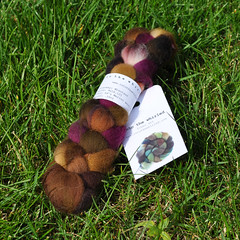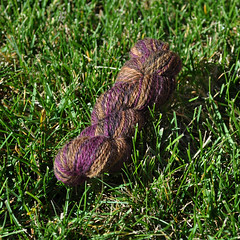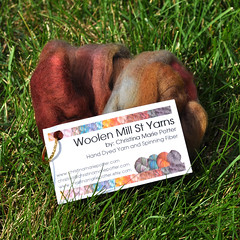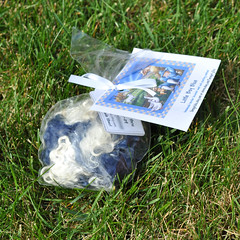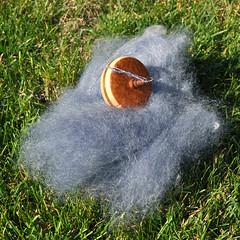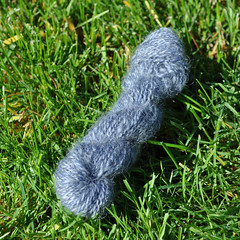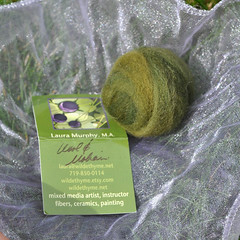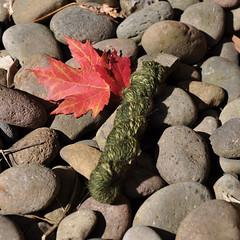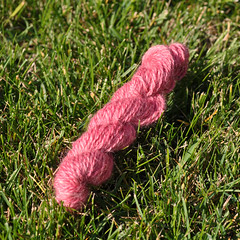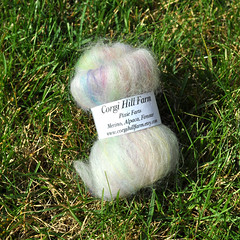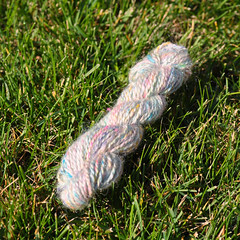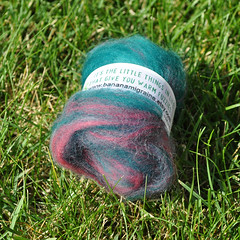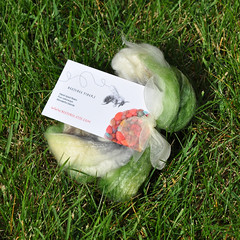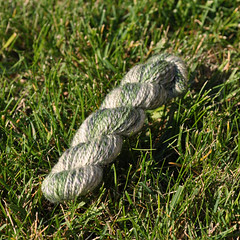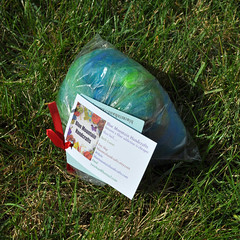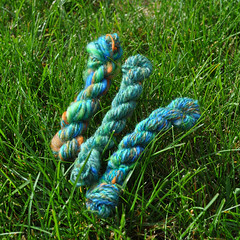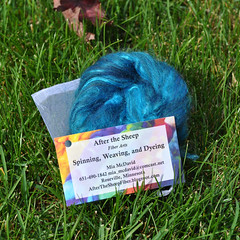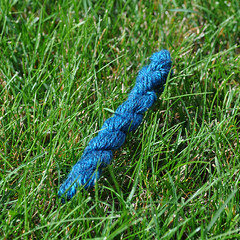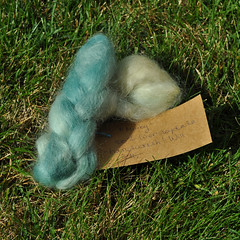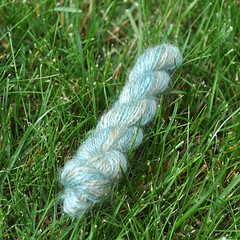This fiber is from a Jacob sheep. Actually, it's from two different Jacob sheep (a mother/daughter pair) owned by a friend of mine from our gym. My penchant for bringing in hand-knit and hand-spun goods prompted her to offer her fleeces to me this last Spring.
I'm afraid I'm rarely one to turn down "free". At the worst, I'm told icky fleece makes awesome mulch. At the best, you can get something amazing. And this, in my opinion, is as close to "the best" as you can get.
Jacob is considered an "unimproved" breed of sheep. Unlike Merino, they haven't gone through a huge amount of selective breeding. They have horns (2, 4, or 6, which go in every direction) and are sturdy sheep. Their wool is two-toned. white and brown/black. You may recall the 'splody sheep. This is those fleeces. They came back lovely and ready to spin. Now I've finally finished about six ounces of the fiber (three white and three brown). Since I spun two full ounces in the month of December, and the Spindler's Challenge theme is "Inspired by Music", this little skein kept me humming "White Christmas". Nothing else in my stash leaped out as a song, so I think that'll be appropriate for December!
I kept trying to spin fingering-weight yarn. I really did. I sampled and kept my single taped to a card for reference. But it always ended up drifting back to sport (maybe just from being nicely springy and fulling up in the wash when I finished). At any rate, I've found a lovely sport-weight pattern for it, and I'm ready to get started knitting very soon!
Sunday, December 27, 2009
Tuesday, December 22, 2009
Ravelry Voting
So, the Phat Fiber group is doing a little contest. There are lots of entries up here (it's a link to the Ravelry Forums, so you'll need a login to get there) and they are supposed to be anonymous. There is some pretty amazing spinning, knitting, crochet and felting up and it's fun to look through. Especially since the entire thread is just pictures and you don't have to wade through ANY chatter to enjoy the pretty.
But I'm in there (twice, once for the knitted object and once with the handspun to make it). Votes are made by clicking on the "love" button on the post.
I'd LOVE(1) it if you'd stop by and look. My entry "should" be obvious.. and I'd love it if you'd Love(1) that! And anything else that you love, of course.. but especially mine ;)
But I'm in there (twice, once for the knitted object and once with the handspun to make it). Votes are made by clicking on the "love" button on the post.
I'd LOVE(1) it if you'd stop by and look. My entry "should" be obvious.. and I'd love it if you'd Love(1) that! And anything else that you love, of course.. but especially mine ;)
Labels:
Not Necessarily Knitting
Saturday, December 19, 2009
Mom's re-shouldered sweater
To quote a friend, "Today I bring you The Rescued Sweater." To understand the full story behind this sweater, you must first go here. And when you're done reading there, come on back for the rest of the tale.
Now, before you close that window down, take a really good look at the shoulder. You can see in GeekKnitter's pictures that the cream color in the body and the cream color in the shoulder don't actually quite match. We tried this sweater on quite a few people and found that the arms were just plain old long. Despite that, my mother (who happened to be visiting at the time... lucky Mom!) loved this sweater. It really is beautiful and a work of art.
I devised a plan. I would (yikes!) separate the sleeves and (YEEEEK!) frog them back, re-knitting what needed to be replaced so that the arms would then be a proper length. If you are weak of heart, you might want to stop reading now.
RIBBIT! RIBBIT! RIBBIT! Yes. I really did. It was no easy task, either. First, I had to bring out my seam-ripper (a pronged tool that is slightly sharpened at the fork so as to allow you to sever sewing thread in a seam with ease--it also parts yarn and cloth with equal ease). I had to rip out the seam inside where the sleeve had been knit long enough to be sewn down over the top of the steeked mess around the armhole. It's a natural mess, but it had been covered up beautifully. After ripping that seam and revealing the mattress stitch within, I carefully picked THAT out and removed the sleeves. Then, I popped the cast-off edge and ... zip, zap, zoom... the top of the sleeves were gone.
About half way in on both sleeves, a new ball had been joined in the knitting (flawlessly, of course). So I took those balls of yarn and skeined them up. I skeined up what remained attached to the sleeve as well and then carefully dunked everything in a hot bath in my sink to get all the kinks out for re-knitting. I dryed and then re-wound a ball of the cream color. With this, I knit a swatch on three different size needles to make sure I would get proper gauge.
Needle sized determined, I returned to the sweater and knit it about half-way back from what I had ripped out. This still left them several inches shorter than their original length. But it gave me a chance to expand the sleeve back to a size that would fit the armscye, and make it the perfect length for Mom (we determined this by making her wear the remains of the sweater and snugged the arm up until it fit right).
As you can see, it came out wonderfully! I tried to put the same care in re-attaching the sleeve as the original creator, but I didn't do it quite the same way. I mattress-stitched the sleeve into each armscye carefully. And then I took the excess (I had knit myself some wiggle room) and I mattress stitched THAT down over the ragged edges of the steek. I'm afraid I'm not a good enough hand with a sewing machine to trust myself to seam down the edge that way. But I know my hand-seaming skills and they were up to the task.
Here's a final look at the new shoulder. It looks snazzy. So does Mom. And now everyone is thrilled that this rescue project has come to a close. Mom says it's deliriously warm. That should serve her quite well for the chilly Winter she'll "enjoy". And I get to warm up with the knowledge that I did a good job putting things back together again.
Now, before you close that window down, take a really good look at the shoulder. You can see in GeekKnitter's pictures that the cream color in the body and the cream color in the shoulder don't actually quite match. We tried this sweater on quite a few people and found that the arms were just plain old long. Despite that, my mother (who happened to be visiting at the time... lucky Mom!) loved this sweater. It really is beautiful and a work of art.
I devised a plan. I would (yikes!) separate the sleeves and (YEEEEK!) frog them back, re-knitting what needed to be replaced so that the arms would then be a proper length. If you are weak of heart, you might want to stop reading now.
RIBBIT! RIBBIT! RIBBIT! Yes. I really did. It was no easy task, either. First, I had to bring out my seam-ripper (a pronged tool that is slightly sharpened at the fork so as to allow you to sever sewing thread in a seam with ease--it also parts yarn and cloth with equal ease). I had to rip out the seam inside where the sleeve had been knit long enough to be sewn down over the top of the steeked mess around the armhole. It's a natural mess, but it had been covered up beautifully. After ripping that seam and revealing the mattress stitch within, I carefully picked THAT out and removed the sleeves. Then, I popped the cast-off edge and ... zip, zap, zoom... the top of the sleeves were gone.
About half way in on both sleeves, a new ball had been joined in the knitting (flawlessly, of course). So I took those balls of yarn and skeined them up. I skeined up what remained attached to the sleeve as well and then carefully dunked everything in a hot bath in my sink to get all the kinks out for re-knitting. I dryed and then re-wound a ball of the cream color. With this, I knit a swatch on three different size needles to make sure I would get proper gauge.
Needle sized determined, I returned to the sweater and knit it about half-way back from what I had ripped out. This still left them several inches shorter than their original length. But it gave me a chance to expand the sleeve back to a size that would fit the armscye, and make it the perfect length for Mom (we determined this by making her wear the remains of the sweater and snugged the arm up until it fit right).
As you can see, it came out wonderfully! I tried to put the same care in re-attaching the sleeve as the original creator, but I didn't do it quite the same way. I mattress-stitched the sleeve into each armscye carefully. And then I took the excess (I had knit myself some wiggle room) and I mattress stitched THAT down over the ragged edges of the steek. I'm afraid I'm not a good enough hand with a sewing machine to trust myself to seam down the edge that way. But I know my hand-seaming skills and they were up to the task.
Here's a final look at the new shoulder. It looks snazzy. So does Mom. And now everyone is thrilled that this rescue project has come to a close. Mom says it's deliriously warm. That should serve her quite well for the chilly Winter she'll "enjoy". And I get to warm up with the knowledge that I did a good job putting things back together again.
Labels:
Designing,
Not Necessarily Knitting,
Odds and Ends,
Sweater
Thursday, December 17, 2009
When good fiber goes bad... or good...
Doesn't this look pretty? This is eight ounces (that's a half pound, or easily enough for two and maybe three pairs of socks) of Blue-faced Leicester commercially combed top. This was once a very plain white braid of fiber to which I applied dye, vinegar, and heat one muggy summer evening. What it produced was lovely to look at, but almost impossible to spin.
Here is the top in its original, pristine state. It's beautiful (as you can tell by my son admiring it back in March of 2009...back before we sheared off his curls!). BFL is a really lovely fiber. It is a longer staple fiber than merino, but can be almost as soft. It is considered to be harder-wearing and excellent for use in socks. I purchased it when I was just getting into the craft of spinning and really had no idea how I would use it, but it was considered an excellent "beginners fiber".
It marinated in my stash until later in the summer I had a few spare moments to dye. I processed the full eight ounces just as I had the smaller braids of Merino I had practiced on earlier. The colors came out nearly as I intended. But what I did not contend with was my own impatience. My efforts to rinse the over-saturated fiber clean resulted in compacting the top and slightly felting the fibers. It was not un-salvageable. But it was going to require stripping the top down and pre-drafting it until everything came loose enough again to work.
If I was going to do all that, I figured, I might as well drum-card the batch! I knew that the Eugene Textile Center would rent out their drum-carder for a full or half-day. And when I went in to use it, the informed me I could also take it home for a daily rate. Using the carder in-store is a juggling act of coordinating schedules. Using the drum-carder at home only requires naptime. Hurray for me!
So what I was able to obtain out of all this are twelve batts, each approximately 3/4 ounce (the most I could get onto the carder without a packing brush). To get this I broke my roving into tiny pieces and jumbled them all together. I created eight batts from the first half of the roving and eight from the second (I got better at packing as I had more practice through the day). I took all these and stacked them every-other one and then divided them in half lengthwise. I took chunks from these batts and re-carded them. And then I did the whole thing a third time, ending with twelve very smooth, well-blended batts. The depth of color does not fully present itself in the picture.
I've started to spin the first one recently and it is lovely. It isn't perfect (but I didn't expect perfection). But I did well listening to all the advice I could before-hand. I didn't over-load the licker-in. I cranked VERY slowly to allow all the fibers to add in smoothly without breaking or turning into tangled nepps. And it worked!
This project does not exist in a complete vacuum. I had decided that my dyed braid would be plied with silk I was already spinning and the resulting yarn would go into a design of my own creation. I think the carded single will pair even better with the silk and the sampling I have done so far yields a positively gorgeous yarn. It just may take me another year to finish it all!
Here is the top in its original, pristine state. It's beautiful (as you can tell by my son admiring it back in March of 2009...back before we sheared off his curls!). BFL is a really lovely fiber. It is a longer staple fiber than merino, but can be almost as soft. It is considered to be harder-wearing and excellent for use in socks. I purchased it when I was just getting into the craft of spinning and really had no idea how I would use it, but it was considered an excellent "beginners fiber".
It marinated in my stash until later in the summer I had a few spare moments to dye. I processed the full eight ounces just as I had the smaller braids of Merino I had practiced on earlier. The colors came out nearly as I intended. But what I did not contend with was my own impatience. My efforts to rinse the over-saturated fiber clean resulted in compacting the top and slightly felting the fibers. It was not un-salvageable. But it was going to require stripping the top down and pre-drafting it until everything came loose enough again to work.
If I was going to do all that, I figured, I might as well drum-card the batch! I knew that the Eugene Textile Center would rent out their drum-carder for a full or half-day. And when I went in to use it, the informed me I could also take it home for a daily rate. Using the carder in-store is a juggling act of coordinating schedules. Using the drum-carder at home only requires naptime. Hurray for me!
So what I was able to obtain out of all this are twelve batts, each approximately 3/4 ounce (the most I could get onto the carder without a packing brush). To get this I broke my roving into tiny pieces and jumbled them all together. I created eight batts from the first half of the roving and eight from the second (I got better at packing as I had more practice through the day). I took all these and stacked them every-other one and then divided them in half lengthwise. I took chunks from these batts and re-carded them. And then I did the whole thing a third time, ending with twelve very smooth, well-blended batts. The depth of color does not fully present itself in the picture.
I've started to spin the first one recently and it is lovely. It isn't perfect (but I didn't expect perfection). But I did well listening to all the advice I could before-hand. I didn't over-load the licker-in. I cranked VERY slowly to allow all the fibers to add in smoothly without breaking or turning into tangled nepps. And it worked!
This project does not exist in a complete vacuum. I had decided that my dyed braid would be plied with silk I was already spinning and the resulting yarn would go into a design of my own creation. I think the carded single will pair even better with the silk and the sampling I have done so far yields a positively gorgeous yarn. It just may take me another year to finish it all!
Tuesday, December 15, 2009
Phat Ulmus
There comes a time when you look in your drawer full of those lovely samples of fiber you JUST COULDN'T RESIST and wonder... what the heck do I do with all this yarn? There's not enough of any one thing to make something out of unless you're into knit jewelry or ear-warmers. But there is enough, combined, to make something lovely if you put your mind to it.
Enter the Ulmus (Ravelry link). Ulmus is a lovely little shawl pattern originally written for two skeins of sock yarn, knit in alternating rows. It is somewhat reminiscent of the ubiquitous Noro Striped Scarf or at least I thought it could be. If managed right, my samples would provide the slow march of color that Noro would normally perform, and work out wonderfully in this shawlette. Ulmus also sports a beautifully subtle pattern of slipped stitches, which I hoped would blend the color changes a bit more.
Happily it worked! I had originally thought to try and make a shawl with a more subtle color progression from one end to the other, but I don't know what sparked the idea of striping. It was serendipity that let one color or another run out early, so the transitions between one type of sample to the next were concealed in the stripes of the other color which remained constant.
Of course, I couldn't just wing it and let it go. I knit most of the way to the end and looked over my work and just did not like the way the colors stripped through the leaf-lace border at all! I very carefully frogged back 15 or 20 rows (I lost count) -- and at the end of a shawl, let me tell you, even five rows is nothing to scoff at ripping back. And I re-arranged the order of the final samples so they blended gently into each other.
I am so very pleased with the final product! Not only was it a joy to knit with my handspun, but I was able to revisit each sample and enjoy again the process of making them and the beauty that each individual Phattie (as the contributors are called) provided! This has become my go-to garment to keep off the encroaching chill. It's wonderful to toss around my neck no matter what else I'm wearing. And with so many colors it is sure to coordinate somehow.
I can't wait to figure out what to do with some of my other bits and pieces!
Enter the Ulmus (Ravelry link). Ulmus is a lovely little shawl pattern originally written for two skeins of sock yarn, knit in alternating rows. It is somewhat reminiscent of the ubiquitous Noro Striped Scarf or at least I thought it could be. If managed right, my samples would provide the slow march of color that Noro would normally perform, and work out wonderfully in this shawlette. Ulmus also sports a beautifully subtle pattern of slipped stitches, which I hoped would blend the color changes a bit more.
Happily it worked! I had originally thought to try and make a shawl with a more subtle color progression from one end to the other, but I don't know what sparked the idea of striping. It was serendipity that let one color or another run out early, so the transitions between one type of sample to the next were concealed in the stripes of the other color which remained constant.
Of course, I couldn't just wing it and let it go. I knit most of the way to the end and looked over my work and just did not like the way the colors stripped through the leaf-lace border at all! I very carefully frogged back 15 or 20 rows (I lost count) -- and at the end of a shawl, let me tell you, even five rows is nothing to scoff at ripping back. And I re-arranged the order of the final samples so they blended gently into each other.
I am so very pleased with the final product! Not only was it a joy to knit with my handspun, but I was able to revisit each sample and enjoy again the process of making them and the beauty that each individual Phattie (as the contributors are called) provided! This has become my go-to garment to keep off the encroaching chill. It's wonderful to toss around my neck no matter what else I'm wearing. And with so many colors it is sure to coordinate somehow.
I can't wait to figure out what to do with some of my other bits and pieces!
Labels:
Designing,
Knitting,
Phat Fiber,
Spindle,
Spinning
Sunday, December 13, 2009
Can you tell the difference?
One of the little things I've dug out lately was some of the yarn I have on hand, but really need to re-purpose. There's nothing intrinsically wrong with the yarn itself, it just isn't exactly to my taste.
Take this lovely skein of hand-spun yarn. It is three-ply, spun on my spindle. It's very nicely even work (if I have to say so myself). But I'm not particularly a fan of the marled effect. And I particularly don't like how yellow the green is.
Enter my stock of Jacquard acid dyes.
I haven't done much dying so far. I played around with it a little with several batches of Merino top, and with eight ounces of BFL (which ended up hopelessly compacted, but that's a different story). Yarn is MUCH more simple to dye. Pre-soak yarn so it's wet. Drop it in a pot with some dye and add heat and acid and VIOLA! you have dyed yarn. There is some small risk of felt occurring, but it is significantly smaller (and less disastrous) than creating an unusable mass of unspun wool.
I didn't even measure. I tossed this skein in a Pyrex dish dedicated to the purpose, put in a glug of vinegar and a glug of "Emerald" dye stock, and tossed it in my "dying microwave" in the garage for 15min on 50%. Come back, and there is exhausted dye solution, and a... well. It's a little greener skein of yarn. I think.
Do you?
Take this lovely skein of hand-spun yarn. It is three-ply, spun on my spindle. It's very nicely even work (if I have to say so myself). But I'm not particularly a fan of the marled effect. And I particularly don't like how yellow the green is.
Enter my stock of Jacquard acid dyes.
I haven't done much dying so far. I played around with it a little with several batches of Merino top, and with eight ounces of BFL (which ended up hopelessly compacted, but that's a different story). Yarn is MUCH more simple to dye. Pre-soak yarn so it's wet. Drop it in a pot with some dye and add heat and acid and VIOLA! you have dyed yarn. There is some small risk of felt occurring, but it is significantly smaller (and less disastrous) than creating an unusable mass of unspun wool.
I didn't even measure. I tossed this skein in a Pyrex dish dedicated to the purpose, put in a glug of vinegar and a glug of "Emerald" dye stock, and tossed it in my "dying microwave" in the garage for 15min on 50%. Come back, and there is exhausted dye solution, and a... well. It's a little greener skein of yarn. I think.
Do you?
Wednesday, December 9, 2009
Where did November go??
Time flies, and not just when you're having fun. When you pile two separate week (or more) familial visits into one month, and then mix in a two week husbandly absence, it's not too shocking that an entire month can disappear into a big black hole of, "Wha??".
Oh, I've gotten things done. Blogging is not one of those things. Neither is taking much in the way of pictures. Smack in the middle of more solo driving here at home and a camera that decided at random not to turn on anymore I'm a bit at a loss. I'm really hoping to share some of the interesting things I've been able to get done sometime soon, but I don't know exactly how quickly that will happen.
Until then, happy knitting to you all. And to all, a good night.
Oh, I've gotten things done. Blogging is not one of those things. Neither is taking much in the way of pictures. Smack in the middle of more solo driving here at home and a camera that decided at random not to turn on anymore I'm a bit at a loss. I'm really hoping to share some of the interesting things I've been able to get done sometime soon, but I don't know exactly how quickly that will happen.
Until then, happy knitting to you all. And to all, a good night.
Labels:
Not Necessarily Knitting
Tuesday, October 20, 2009
Lace Single SAL
I've been going through Ravelry and "cleaning house". That means looking at what groups I read and don't read, where I post often, occasionally, or never and then reordering the active ones to the "front" and dropping those I don't really use. I usually end up picking up one or two new ones right before I clean up, because they need to get sorted in amongst the rest and that triggers the whole thing.
One of the boards I added recently was "Spinner Central". This is a group for hand-spinners that work on any tool--wheel or spindle. I enjoyed looking through the more general topics that can be applied to anything. It also has a quarterly SAL/KAL (that's a Spin-a-Long/Knit-a-Long) and we all know I'm a sucker for this sort of thing. I enjoy getting pushed to try new things, and any excuse to post what I'm working on is great!
The SAL this time around is "lace-weight singles". I'm not much of a singles person. I've bought some, commercially made, and spun them once or twice. But in general I love a tightly-plied yarn.
I was in-between projects, and it probably didn't hurt that I enjoyed a beer with my pizza for dinner and as the kids were safely tucked away in bed, suddenly spinning a lace-weight single yarn seemed really interesting. And here I have all these great samples to play with that I had no clue how to use!
In specific I had a grab-bag of "exotics" from A Verb for Keeping Warm that I had purchased as part of my Sock Summit '09 loot. Dreamy stuff. Soft. Beautiful colors, all natural or naturally-dyed. I picked three that looked like they might go well together. At "noon", "one" and "two o'clock" there is grey, red, and brown fiber. I wasn't sure what they were, but they were lovely and I thought they'd blend well together.
I started with the silver/gray fiber. Oh, it was soft and smooth and started spinning so easily. About half way through I broke off a few sections of it, and some of the brown fiber, and carefully blended them together in increasing amounts of brown. I hoped this would blend one into the next in a slow gradient. I'm not sure how successful it was, but it's still pretty. And of course next was the chocolate brown and just like the silver it was smooth and wonderful.
But when I got to the red/brown fiber, I started to have trouble. It's quite soft, too, but with a much less silky hand. The staple was much shorter and it seemed slightly "sticky". The fibers wanted to grab each other, rather than slide easily. I struggled with blending the deep brown into the red, but managed to get that far. But my single kept being difficult to manage. I'd draft it apart without warning, or get slubs.
Rather than drive myself crazy, I pulled out my hand cards and re-carded this last roving. I was hoping it would open up the fibers and make them easier to draft, and it did help. But I still had trouble keeping it moving smoothly. I tried some of it on my supported spindle, but it was to grabby to long-draw well. In addition, I noticed as I worked under bright light that when I did draft through a grabby section, there were wisps of "smoke" drifting upwards from the fiber... ACK. It was DIRT.
I pressed on and finished spinning, but with a sad feeling for the state of this fiber. Especially when the first two were so lovely.
After, I went to the "A Verb for Keeping Warm" Ravelry group and posted a plea to help me figure out what the fibers were. I guessed the samples I had spun were gray alpaca, brown alpaca and merino/yak blend, and wouldn't you know it but THE OWNER replied and helped me out. She ventured that I had:
I'm happy/disappointed with the merino/yak. My bits and samples of this from trying various methods on spinning it yielded yarn that is positively to die for. It's soft and cuddly, springy, and vibrant. But spinning it was a total pain. I might have to try some more to find out if it was the sample, or characteristic of the blend, because I want more of this yarn.
The lace single came out in the end. It's so incredibly soft I want to carry it around and make people pet it. I think I'll be making a Revontuli (pdf link) in a scarf-size out of it. This is another yarn that is going to have to wait for the idea to grab me and say "YES, THIS IS IT!!"
One of the boards I added recently was "Spinner Central". This is a group for hand-spinners that work on any tool--wheel or spindle. I enjoyed looking through the more general topics that can be applied to anything. It also has a quarterly SAL/KAL (that's a Spin-a-Long/Knit-a-Long) and we all know I'm a sucker for this sort of thing. I enjoy getting pushed to try new things, and any excuse to post what I'm working on is great!
The SAL this time around is "lace-weight singles". I'm not much of a singles person. I've bought some, commercially made, and spun them once or twice. But in general I love a tightly-plied yarn.
I was in-between projects, and it probably didn't hurt that I enjoyed a beer with my pizza for dinner and as the kids were safely tucked away in bed, suddenly spinning a lace-weight single yarn seemed really interesting. And here I have all these great samples to play with that I had no clue how to use!
In specific I had a grab-bag of "exotics" from A Verb for Keeping Warm that I had purchased as part of my Sock Summit '09 loot. Dreamy stuff. Soft. Beautiful colors, all natural or naturally-dyed. I picked three that looked like they might go well together. At "noon", "one" and "two o'clock" there is grey, red, and brown fiber. I wasn't sure what they were, but they were lovely and I thought they'd blend well together.
I started with the silver/gray fiber. Oh, it was soft and smooth and started spinning so easily. About half way through I broke off a few sections of it, and some of the brown fiber, and carefully blended them together in increasing amounts of brown. I hoped this would blend one into the next in a slow gradient. I'm not sure how successful it was, but it's still pretty. And of course next was the chocolate brown and just like the silver it was smooth and wonderful.
But when I got to the red/brown fiber, I started to have trouble. It's quite soft, too, but with a much less silky hand. The staple was much shorter and it seemed slightly "sticky". The fibers wanted to grab each other, rather than slide easily. I struggled with blending the deep brown into the red, but managed to get that far. But my single kept being difficult to manage. I'd draft it apart without warning, or get slubs.
Rather than drive myself crazy, I pulled out my hand cards and re-carded this last roving. I was hoping it would open up the fibers and make them easier to draft, and it did help. But I still had trouble keeping it moving smoothly. I tried some of it on my supported spindle, but it was to grabby to long-draw well. In addition, I noticed as I worked under bright light that when I did draft through a grabby section, there were wisps of "smoke" drifting upwards from the fiber... ACK. It was DIRT.
I pressed on and finished spinning, but with a sad feeling for the state of this fiber. Especially when the first two were so lovely.
After, I went to the "A Verb for Keeping Warm" Ravelry group and posted a plea to help me figure out what the fibers were. I guessed the samples I had spun were gray alpaca, brown alpaca and merino/yak blend, and wouldn't you know it but THE OWNER replied and helped me out. She ventured that I had:
12 o’clock - 100% baby alpaca - silverLooks like I did a good job guessing!
1 o’clock - 50% yak / 50% merino
3 o’clock - 100% baby alpaca - brown
6 o’clock - 100% cashmere
8 o’clock - pretty sure it’s 50% camel / 50% silk
10 o’clock - pretty sure it’s 50% merino / 50% silk
I'm happy/disappointed with the merino/yak. My bits and samples of this from trying various methods on spinning it yielded yarn that is positively to die for. It's soft and cuddly, springy, and vibrant. But spinning it was a total pain. I might have to try some more to find out if it was the sample, or characteristic of the blend, because I want more of this yarn.
The lace single came out in the end. It's so incredibly soft I want to carry it around and make people pet it. I think I'll be making a Revontuli (pdf link) in a scarf-size out of it. This is another yarn that is going to have to wait for the idea to grab me and say "YES, THIS IS IT!!"
Monday, October 19, 2009
What to do with a yarn
And.. I'm done! It didn't take nearly as long to spin as I might have liked (because spinning this blend was glorious!). The blend was lovely to touch and spun out super-fine.
I've come to a point where for most things I spin with a purpose in mind. I buy a fiber for a project and attempt to spin it to specifications that would allow me to knit the intended object, or at the very least I figure out what I want to knit before I start spinning an impulse fiber purchase. But other times I fall in love with a sample because of its color or texture and can't help myself but splurge. These things tend to get spun up however I'm feeling at the time with no real plan. It's a lot of fun but the down-side is that I'm likely to end up with a very small amount of yarn that is lovely, but I have no way of making or getting more!
With this yarn I had a brief moment where I debated whether to put it together as a 2-ply or a 3-ply. I love 3-ply. It's round and shows stitches wonderfully. It also eats up a lot more of your precious spinning. For example I could have had around 200 yards of 2-ply lace. But 200 yards of lace is difficult to apply to a project. I'd like at least twice that to make it worth the effort of knitting up.
On the other hand, 3-ply reduces the yardage to 140 yards and that can be just as difficult to purpose. Still, I like that more and it's enough for fingerless mittens, or a neck-warming type cowl.. or Spiraluscious by Anne Hanson which just happens to be a pattern I've had in my queue since I first saw it.
I'm still debating. I have a lovely periwinkle dye that I think would be beautiful on this yarn, but the natural color glows and it's difficult to want to cover that up. I'm letting the idea percolate a little bit while I finish up all the other things I'm working on. I'm sure the right match will occur to me, eventually!
I've come to a point where for most things I spin with a purpose in mind. I buy a fiber for a project and attempt to spin it to specifications that would allow me to knit the intended object, or at the very least I figure out what I want to knit before I start spinning an impulse fiber purchase. But other times I fall in love with a sample because of its color or texture and can't help myself but splurge. These things tend to get spun up however I'm feeling at the time with no real plan. It's a lot of fun but the down-side is that I'm likely to end up with a very small amount of yarn that is lovely, but I have no way of making or getting more!
With this yarn I had a brief moment where I debated whether to put it together as a 2-ply or a 3-ply. I love 3-ply. It's round and shows stitches wonderfully. It also eats up a lot more of your precious spinning. For example I could have had around 200 yards of 2-ply lace. But 200 yards of lace is difficult to apply to a project. I'd like at least twice that to make it worth the effort of knitting up.
On the other hand, 3-ply reduces the yardage to 140 yards and that can be just as difficult to purpose. Still, I like that more and it's enough for fingerless mittens, or a neck-warming type cowl.. or Spiraluscious by Anne Hanson which just happens to be a pattern I've had in my queue since I first saw it.
I'm still debating. I have a lovely periwinkle dye that I think would be beautiful on this yarn, but the natural color glows and it's difficult to want to cover that up. I'm letting the idea percolate a little bit while I finish up all the other things I'm working on. I'm sure the right match will occur to me, eventually!
Labels:
Spinning
Sunday, October 18, 2009
Hand-carded Pygora blend
It's so much easier to blog each day when you get ahead of yourself! I don't mind letting you in on a little secret--I'm writing several posts all at once and then letting them play out over time ;) I hope that's okay!
This lovely little bit of fluff is pygora. But it's not just pygora. I have delved once again into blending with my hand-cards and made a series of batts that blend soft cream pygora with white merino/silk top. You may remember the half-ounce I picked up at Stitches Midwest. This type B pygora (which means it's a blend of cashmere-type coat and very soft mohair-type) was too tempting to pass up. But what to do with 1/2 ounce?
I have been stretching it in this blend. I added enough merino/silk to bring it to a full ounce. I then carded a series of batts with each fiber in it, stacked them and pulled of sections that included all the previous batts and re-carded that. And then did it again. And one more time. I really wanted a smooth, complete blend.
The pygora was a little disappointing. I was very surprised when I pulled it out of its package to find that the ends of the batt that had been tucked into the middle were matted together. I had a very hard time pulling it apart. While carding, I found that the fiber isn't particularly uniform and has quite a bit of tiny neps in it. Some sections spin out into extremely uniform thread, but I often happen into an area that is harder to draft, or has these tangles of fiber that just want to stick together.
It is deliciously soft. It is hard not to just stop and pet the carded batts and enjoy it unspun. It also has a lovely luster. I'm hoping the finished lace-weight yarn will make a very nice scarf or neck-warmer. I'll have to decide when I'm done whether or not I'll dye the lot of it a color, or leave it in its natural off-white.
This lovely little bit of fluff is pygora. But it's not just pygora. I have delved once again into blending with my hand-cards and made a series of batts that blend soft cream pygora with white merino/silk top. You may remember the half-ounce I picked up at Stitches Midwest. This type B pygora (which means it's a blend of cashmere-type coat and very soft mohair-type) was too tempting to pass up. But what to do with 1/2 ounce?
I have been stretching it in this blend. I added enough merino/silk to bring it to a full ounce. I then carded a series of batts with each fiber in it, stacked them and pulled of sections that included all the previous batts and re-carded that. And then did it again. And one more time. I really wanted a smooth, complete blend.
The pygora was a little disappointing. I was very surprised when I pulled it out of its package to find that the ends of the batt that had been tucked into the middle were matted together. I had a very hard time pulling it apart. While carding, I found that the fiber isn't particularly uniform and has quite a bit of tiny neps in it. Some sections spin out into extremely uniform thread, but I often happen into an area that is harder to draft, or has these tangles of fiber that just want to stick together.
It is deliciously soft. It is hard not to just stop and pet the carded batts and enjoy it unspun. It also has a lovely luster. I'm hoping the finished lace-weight yarn will make a very nice scarf or neck-warmer. I'll have to decide when I'm done whether or not I'll dye the lot of it a color, or leave it in its natural off-white.
Saturday, October 17, 2009
SKA September 2009 - Nancy Bush Mystery Socks
I'm a bit behind. These socks have been done for a couple of weeks but I've been diligently getting all the fiber blog posts up for the Phat Fiber box. It has been fun detailing each sample in the series.
September kicked off the Sock Knitters Anonymous "Sockdown" season. This group on Ravelry is dedicated to stretching sock knitters to their limits, challenging each month with a different theme.
Our first challenge is the only one of the year to focus on a color, rather than a knitting skill. The requirements were to either a) knit a sock in yellow (solid or semi-solid only) or b) knit a sock designed by Wendy Johnson. Option C was the "Mystery Sock", and it falls under the first heading and was required to be knit in yellow.
I bought String Theory's yellow sock yarn called "Caper". I didn't have any pure yellow in my stash. Of course you can always knit any sock any way you want... but there are prizes involved and that tiny, little competitive urge that I have from time to time started nagging. I just couldn't participate in the group and NOT knit a project that qualified for the prize drawing. I don't expect to win anything (except a beautiful pair of socks).
Nancy Bush did this Mystery design and it's lovely. The final name is "Fox Faces". With a little imagination you can see them peering at you in the picture.
The challenge for me is to knit a Mystery Sock with complete faith in the designer. I followed every instruction that I could, and in a couple of places figured out much later I'd done it a little bit wrong. But that's okay, too. I learned an Estonian cast on (very pretty) and what Nancy Bush calls a "vikkel braid", which really just means a sideways braid. The back of the calf is knit in ribbing, but not all the way to the ankle. I don't like that, but I'm rolling with the pattern here.
The heels I did end up needing to change and probably could have done more to them. I knit the heel flap about twice as long and thus doubled the gusset as well. I probably needed to do more, but I'm not ripping out to do these again. The Dutch heel is very pretty and easy to make. I might use it again in another sock. It fits well, but I do need it to be a lot deeper to accommodate my high instep.
I slipped up and didn't switch to stockinette two inches before the toes, but I don't think it hurts to have the lace all the way down. That was entirely a "woops" moment and not me tinkering with the aesthetics of the pattern. I simply didn't pull it out to consult while I was knitting and tried to do things from memory.
The yarn has a touch of cashmere in it and the yellow is really lovely. It is so nice to do something like this on faith and have it come out so well. I may even do the mystery sock in November!
September kicked off the Sock Knitters Anonymous "Sockdown" season. This group on Ravelry is dedicated to stretching sock knitters to their limits, challenging each month with a different theme.
Our first challenge is the only one of the year to focus on a color, rather than a knitting skill. The requirements were to either a) knit a sock in yellow (solid or semi-solid only) or b) knit a sock designed by Wendy Johnson. Option C was the "Mystery Sock", and it falls under the first heading and was required to be knit in yellow.
I bought String Theory's yellow sock yarn called "Caper". I didn't have any pure yellow in my stash. Of course you can always knit any sock any way you want... but there are prizes involved and that tiny, little competitive urge that I have from time to time started nagging. I just couldn't participate in the group and NOT knit a project that qualified for the prize drawing. I don't expect to win anything (except a beautiful pair of socks).
Nancy Bush did this Mystery design and it's lovely. The final name is "Fox Faces". With a little imagination you can see them peering at you in the picture.
The challenge for me is to knit a Mystery Sock with complete faith in the designer. I followed every instruction that I could, and in a couple of places figured out much later I'd done it a little bit wrong. But that's okay, too. I learned an Estonian cast on (very pretty) and what Nancy Bush calls a "vikkel braid", which really just means a sideways braid. The back of the calf is knit in ribbing, but not all the way to the ankle. I don't like that, but I'm rolling with the pattern here.
The heels I did end up needing to change and probably could have done more to them. I knit the heel flap about twice as long and thus doubled the gusset as well. I probably needed to do more, but I'm not ripping out to do these again. The Dutch heel is very pretty and easy to make. I might use it again in another sock. It fits well, but I do need it to be a lot deeper to accommodate my high instep.
I slipped up and didn't switch to stockinette two inches before the toes, but I don't think it hurts to have the lace all the way down. That was entirely a "woops" moment and not me tinkering with the aesthetics of the pattern. I simply didn't pull it out to consult while I was knitting and tried to do things from memory.
The yarn has a touch of cashmere in it and the yellow is really lovely. It is so nice to do something like this on faith and have it come out so well. I may even do the mystery sock in November!
Friday, October 16, 2009
Jacob wool
As if I needed further confirmation that my default spinning thickness isn't lace... I played around with the Jacob fleece I was gifted last Spring.
This is a beautiful fleece. For Jacob (which is an unimproved breed and the wool much more robust than fine) this is a very nice and soft fleece! Jacob has both white and dark sections and this is obviously from the black. It is BEAUTIFUL.
Because I hardly did a perfect job separating the two colors, there are a few strands of white here-and-there throughout the roving. It gives the yarn a very nice character. Spinning "reasonably thin" and then chain-plying the yarn yielded a bouncy yarn with a lot of character. It swatches at 6 stitches per inch, which is Sport weight on the chart I have.
The best part was taking this swatch into the owner. She rescued her two Jacob sheep and was originally fairly apprehensive about having done so. But she loves them now and the excitement in seeing the fleece actually used is just wonderful.
I can't wait to make something really special.
This is a beautiful fleece. For Jacob (which is an unimproved breed and the wool much more robust than fine) this is a very nice and soft fleece! Jacob has both white and dark sections and this is obviously from the black. It is BEAUTIFUL.
Because I hardly did a perfect job separating the two colors, there are a few strands of white here-and-there throughout the roving. It gives the yarn a very nice character. Spinning "reasonably thin" and then chain-plying the yarn yielded a bouncy yarn with a lot of character. It swatches at 6 stitches per inch, which is Sport weight on the chart I have.
The best part was taking this swatch into the owner. She rescued her two Jacob sheep and was originally fairly apprehensive about having done so. But she loves them now and the excitement in seeing the fleece actually used is just wonderful.
I can't wait to make something really special.
Thursday, October 15, 2009
October Spindler's Challenge
I've had this yarn spun for a while now, but the blogging took back seat to getting all the Phat Fiber Box samples finished up. They were addicting while they lasted! But now we have our monthly Spindler's challenge.
I often try to sneak the Spindler's Challenge in as some other fiber-project I'm doing for another reason. That works out well enough, but sometimes it just feels like a cheat not to give the challenge its own attention. I like to stretch myself by trying out some new technique each month for the Challenge spinning, because that puts my own little twist on it. Har. Har. This month I decided to go back to that personal promise.
October's theme is "Stained Glass". I love stained glass. I love the light pouring through it. When looking for a new church, I've gone back to buildings where I didn't feel immediately that I fit in, just because I like to sit under the glorious play of color there. There is one window in particular in my home-town church that portrays Jesus's last night in the garden of Gesthemane. Not only is this a compelling story on its own, but the glass is beautifully done. On a sunny day, the blues and purples glow, with golden light shining down through them both figuratively and literally. I loved it so much that I required our photographer to get one picture of me in front of it on my wedding day.
I had plenty of bits of roving that caught these colors individually, but I wanted to have a more subtle variation like the play of light through the glass. I've also been reading lately about blending colors through the use of hand cards. So I thought I would tackle a whole bunch of different ideas at the same time.
The first thing I did was divide the roving into lots of small pieces. I jumbled these up and then picked out a few at a time and loaded them onto my student hand cards (which I still have from my very first spinning class about four years ago). I transferred all the loaded fibers from one paddle to the other. This does a couple of things. Commercially combed top is a preparation of fiber where everything is lined up parallel, and is rather compact. Carded batts jumble all the fibers together, criss-crossing in a lot of places. It also allows a lot of air in between everything. A batt is fluffy. I pulled the fibers off and carded them again until I had an even batt on one carder, and then carefully pulled that off and rolled it up for safe-keeping.
Then I spun these batts. My second challenge to myself lately has been to spin long-draw. I'm a pretty self-controlling person and short-draw suits that style much better. You always have control over the fiber when spinning with a short-draw. With long-draw, you have to back off a bit and trust the twist and friction to do their job, too. As you get better at it, it's pretty fascinating to watch the twist grab just the right amount of fiber and pull it into the growing strand. You have to let just enough more twist in to keep that going. Too much, and you get a sudden thick spot in your spinning. Too little and it all falls apart.
But once you get the rhythm down, long draw is fast. I couldn't believe how quickly I got through all the batts (although I suppose I shouldn't be shocked as I had a little under an ounce to work with). Winding off an plying took almost no time at all and I was left with around 53 yards of 3-ply yarn. It's lovely and fluffy and I'm really pleased with the play of color throughout. I think I'll probably combine it with some of the merino samples I spun earlier this year for a gift.
I often try to sneak the Spindler's Challenge in as some other fiber-project I'm doing for another reason. That works out well enough, but sometimes it just feels like a cheat not to give the challenge its own attention. I like to stretch myself by trying out some new technique each month for the Challenge spinning, because that puts my own little twist on it. Har. Har. This month I decided to go back to that personal promise.
October's theme is "Stained Glass". I love stained glass. I love the light pouring through it. When looking for a new church, I've gone back to buildings where I didn't feel immediately that I fit in, just because I like to sit under the glorious play of color there. There is one window in particular in my home-town church that portrays Jesus's last night in the garden of Gesthemane. Not only is this a compelling story on its own, but the glass is beautifully done. On a sunny day, the blues and purples glow, with golden light shining down through them both figuratively and literally. I loved it so much that I required our photographer to get one picture of me in front of it on my wedding day.
I had plenty of bits of roving that caught these colors individually, but I wanted to have a more subtle variation like the play of light through the glass. I've also been reading lately about blending colors through the use of hand cards. So I thought I would tackle a whole bunch of different ideas at the same time.
The first thing I did was divide the roving into lots of small pieces. I jumbled these up and then picked out a few at a time and loaded them onto my student hand cards (which I still have from my very first spinning class about four years ago). I transferred all the loaded fibers from one paddle to the other. This does a couple of things. Commercially combed top is a preparation of fiber where everything is lined up parallel, and is rather compact. Carded batts jumble all the fibers together, criss-crossing in a lot of places. It also allows a lot of air in between everything. A batt is fluffy. I pulled the fibers off and carded them again until I had an even batt on one carder, and then carefully pulled that off and rolled it up for safe-keeping.
Then I spun these batts. My second challenge to myself lately has been to spin long-draw. I'm a pretty self-controlling person and short-draw suits that style much better. You always have control over the fiber when spinning with a short-draw. With long-draw, you have to back off a bit and trust the twist and friction to do their job, too. As you get better at it, it's pretty fascinating to watch the twist grab just the right amount of fiber and pull it into the growing strand. You have to let just enough more twist in to keep that going. Too much, and you get a sudden thick spot in your spinning. Too little and it all falls apart.
But once you get the rhythm down, long draw is fast. I couldn't believe how quickly I got through all the batts (although I suppose I shouldn't be shocked as I had a little under an ounce to work with). Winding off an plying took almost no time at all and I was left with around 53 yards of 3-ply yarn. It's lovely and fluffy and I'm really pleased with the play of color throughout. I think I'll probably combine it with some of the merino samples I spun earlier this year for a gift.
Labels:
Spindle,
Spindler's Challenge,
Spinning
Wednesday, October 14, 2009
Cormo, Romeldale, Qiviut blend
So, on a lark, my daughter and I hopped in the car on a particular Sunday and drove an hour-and-a-half up to Canby, Oregon to attend the Oregon Flock and Fiber Festival (otherwise known as OFFF). Just like the Black Sheep Gathering in Eugene, this is a great opportunity to get some neat wool and products from other independent retailers.
As I looked through the Bellwether Wool booth (while simultaneously making a fool of myself for confusing them with Ask the Bellwether.. I'd chalk it up to lack-of-sleep but it was really just plain DUH-ness) I pulled out a small roll of fiber. It was labeled "Cormo, Romeldale, and Qiviut" and was $6 for one ounce.
Now, I can get undyed Merino for $1.50/ounce. But qiviut can be found for anywhere between $45-$75 per ounce. You could SHAKE a batt of qiviut at any other roving, and the price would go up. So I didn't really even turn an eyelash at the price.
Lois Olund (who had apparently forgiven me for my moment of idiocy) came over and explained that they had acquired an entire musk ox pelt from a friend in Alaska. And realizing what they had, they sat down with it on the floor and combed the qiviut out of it. What I had in my hand was a result of this labor.
Now how could I resist a story like that? I took the roll home with me. Just one ounce, I reasoned, would be plenty to play with and enough to get lace-weight out of for a cowl.
I stopped and grabbed up my copy of In Sheep's Clothing to read up on Cormo and Romeldale. Cormo, it turns out, is an Australian cross of Corriedale rams with Merino ewes-- so it's a bit more hardy than a Merino, but with tons of crimp just like its momma's wool. It's not quite Merino soft, but still is very soft. Romeldale is another hardier cross, using Rambouillet (named for the place where King Louis XVI established a flock of Spanish Merinos) ewes and Romney rams. Basically what this means is there is a blend of wool that is very close to Merino, but perhaps just a touch more sturdy... with a nice pinch of ultra-soft-and-fine-qiviut blended in.
YUM.
I took off spinning this with a careful long-draw, thinking I'd get two-ply lace out of it. It would be PERFECT for the recently released Pretty Thing (thank you Yarn Harlot!! I've been waiting on that since February). My sample was a nice lace-weight, but what I forget is that when I start having fun, my default is closer to two-ply fingering or even sport.
I enjoyed myself immensely, finished off the ounce, and pulled out the trusty niddy-noddy. When wound, I had 114 wraps, to which I must apply some minor math (114 wraps * 58 inches in a wrap / 36 inches in a yard) and got... 180-ish yards. That's only 90 yards of 2-ply and the Yarn Harlot is pretty clear you need about 164 yards. I said some awful things to myself in my head and started debating options.
I could knit with the single. But I had spun this with the intention to ply and therefor it had a pretty reasonable twist in it (I like firmly plied yarns). So that's a bit iffy. I could spin silk and ply with that. But I didn't really want the shiny strand offsetting the deliciously soft and natural color. I could ply with the pygora I purchased, but really I wanted that in its own project.
So the next morning I bit the bullet and e-mailed Lois to see if she didn't (oh, please!) have just one more ounce of this luscious blend that I could somehow purchase and have sent to me?
Well, YES! Lois replied a mere two hours later (and at a much more reasonable hour than the 5 A.M. I was forced to be awake that morning). In fact, she told me, "I have a pound, if you'd like it.".
Well, yes, I would. But I only need one more ounce, and one more ounce is what I asked to be sent. I have pounds of other things that still need to be spun without adding to it!
But boy.. it was tempting.
If you're tempted, you should write her! (Her contact information is on their website at www.bellwetherwool.com). Really. You should. You know you want some, too!
As I looked through the Bellwether Wool booth (while simultaneously making a fool of myself for confusing them with Ask the Bellwether.. I'd chalk it up to lack-of-sleep but it was really just plain DUH-ness) I pulled out a small roll of fiber. It was labeled "Cormo, Romeldale, and Qiviut" and was $6 for one ounce.
Now, I can get undyed Merino for $1.50/ounce. But qiviut can be found for anywhere between $45-$75 per ounce. You could SHAKE a batt of qiviut at any other roving, and the price would go up. So I didn't really even turn an eyelash at the price.
Lois Olund (who had apparently forgiven me for my moment of idiocy) came over and explained that they had acquired an entire musk ox pelt from a friend in Alaska. And realizing what they had, they sat down with it on the floor and combed the qiviut out of it. What I had in my hand was a result of this labor.
Now how could I resist a story like that? I took the roll home with me. Just one ounce, I reasoned, would be plenty to play with and enough to get lace-weight out of for a cowl.
I stopped and grabbed up my copy of In Sheep's Clothing to read up on Cormo and Romeldale. Cormo, it turns out, is an Australian cross of Corriedale rams with Merino ewes-- so it's a bit more hardy than a Merino, but with tons of crimp just like its momma's wool. It's not quite Merino soft, but still is very soft. Romeldale is another hardier cross, using Rambouillet (named for the place where King Louis XVI established a flock of Spanish Merinos) ewes and Romney rams. Basically what this means is there is a blend of wool that is very close to Merino, but perhaps just a touch more sturdy... with a nice pinch of ultra-soft-and-fine-qiviut blended in.
YUM.
I took off spinning this with a careful long-draw, thinking I'd get two-ply lace out of it. It would be PERFECT for the recently released Pretty Thing (thank you Yarn Harlot!! I've been waiting on that since February). My sample was a nice lace-weight, but what I forget is that when I start having fun, my default is closer to two-ply fingering or even sport.
I enjoyed myself immensely, finished off the ounce, and pulled out the trusty niddy-noddy. When wound, I had 114 wraps, to which I must apply some minor math (114 wraps * 58 inches in a wrap / 36 inches in a yard) and got... 180-ish yards. That's only 90 yards of 2-ply and the Yarn Harlot is pretty clear you need about 164 yards. I said some awful things to myself in my head and started debating options.
I could knit with the single. But I had spun this with the intention to ply and therefor it had a pretty reasonable twist in it (I like firmly plied yarns). So that's a bit iffy. I could spin silk and ply with that. But I didn't really want the shiny strand offsetting the deliciously soft and natural color. I could ply with the pygora I purchased, but really I wanted that in its own project.
So the next morning I bit the bullet and e-mailed Lois to see if she didn't (oh, please!) have just one more ounce of this luscious blend that I could somehow purchase and have sent to me?
Well, YES! Lois replied a mere two hours later (and at a much more reasonable hour than the 5 A.M. I was forced to be awake that morning). In fact, she told me, "I have a pound, if you'd like it.".
Well, yes, I would. But I only need one more ounce, and one more ounce is what I asked to be sent. I have pounds of other things that still need to be spun without adding to it!
But boy.. it was tempting.
If you're tempted, you should write her! (Her contact information is on their website at www.bellwetherwool.com). Really. You should. You know you want some, too!
Tuesday, October 13, 2009
Phat Fiber Box Wrap-up - September 2009
Well, we're all done with Phat Fiber and there's nothing left to discuss... or is there?
Here's a line-up of all the yarn I spun from the samples. There is milk, linen, domestic wool, bamboo, Merino, Wensleydale, Shetland, alpaca, sparkle and who knows what else. They were prepared as commercial top and carded batts in braids, coils, twists and poofs. Most of my spun samples are 2-ply, but there is one 3-ply in there, and one single.
I have them lined up in a row because I'm considering knitting them for a project in this order. The single, and the linen, are off to the side because they simply don't blend in with the rest of the yarn. They are lovely in their own right and might become a beaded bracelet or something else that is fun. When totaling the skeins I have picked out to use, there is just over 460 yards. I've already designed a project and will probably knit it sometime this month. We'll see.
Because I'm a bit of a numbers girl, I can't help but sit down and figure out what exactly I paid to get.
If we total what everyone included we have:
5.2 + 6.8 + 2.5 + 6 + 7.8 + 9.9 + 5.4 + 12.2 + 8.9 + 7.4 + 9 + 10.2 + 5.5 + 14 + 6.6 + 28 = 145.4 g or 5.1 ounces. Those that sent in larger samples seem to have outweighed those that didn't. (Otherwise 16 samples at 1/4 ounce each should be 4 ounces).
The box was $33 so it comes out to about $6.60 per ounce. That's a little steep compared to what I can buy a carded batt for on Etsy if all we are looking at here is fiber but that doesn't take into account the discount coupons and little extras that were put in the package as well, nor the variety and other intangibles that came in this box.
Considering how many different and wonderful things I got to try and how many new shops I got to try out through this sampler, it was worth every penny.
Here's a line-up of all the yarn I spun from the samples. There is milk, linen, domestic wool, bamboo, Merino, Wensleydale, Shetland, alpaca, sparkle and who knows what else. They were prepared as commercial top and carded batts in braids, coils, twists and poofs. Most of my spun samples are 2-ply, but there is one 3-ply in there, and one single.
I have them lined up in a row because I'm considering knitting them for a project in this order. The single, and the linen, are off to the side because they simply don't blend in with the rest of the yarn. They are lovely in their own right and might become a beaded bracelet or something else that is fun. When totaling the skeins I have picked out to use, there is just over 460 yards. I've already designed a project and will probably knit it sometime this month. We'll see.
Because I'm a bit of a numbers girl, I can't help but sit down and figure out what exactly I paid to get.
If we total what everyone included we have:
5.2 + 6.8 + 2.5 + 6 + 7.8 + 9.9 + 5.4 + 12.2 + 8.9 + 7.4 + 9 + 10.2 + 5.5 + 14 + 6.6 + 28 = 145.4 g or 5.1 ounces. Those that sent in larger samples seem to have outweighed those that didn't. (Otherwise 16 samples at 1/4 ounce each should be 4 ounces).
The box was $33 so it comes out to about $6.60 per ounce. That's a little steep compared to what I can buy a carded batt for on Etsy if all we are looking at here is fiber but that doesn't take into account the discount coupons and little extras that were put in the package as well, nor the variety and other intangibles that came in this box.
Considering how many different and wonderful things I got to try and how many new shops I got to try out through this sampler, it was worth every penny.
Labels:
Phat Fiber,
Spindle,
Spinning
Monday, October 12, 2009
Into the Whirled - Phat Fiber Sample
It was with some sadness that I picked up the final sample from the September 2009 Phat Fiber box. It had been a fun ride and had its ups and downs, but I was going to miss getting to go to my big box and pull out something random! (This is not entirely true, as I have plenty of other random stuff to spin.. just not quite THIS random!)
But I saved the "best" for last. I will admit that many other fibers in this box wowed me, but this sample from Into the Whirled had me drooling from the start. Fine merino at its best, it had been dyed into a lovely colorway named "Minotaur" in honor of the September theme. Cris did a great job.
Not only that, but every single contributor to Phat Fiber ought to take a look at the labeling on this sample. First off, she sent a full 1/2 ounce. That's way above and beyond the requirements. I do wonder if I somehow got a "bonus sample" but we'll at least give her full credit for more than 1/4 ounce, right? On top of that her fiber is VERY CLEARLY LABLED. It has full fiber content (admittedly not a mix, but still there were some with no information at all). It has the colorway and dyelot. It has the weight right there. In addition the back of the tag tied to the braid has space for all of this information to be re-written AND space for WPI, yardage and other spinning notes.
The colors were rich and evocative of the name. On top of that they're very fall-appropriate and I liked them, so she really hit the nail right on the head. The combed top spun just like I would like Merino to do--smoothly, easily and evenly, with no felted clumps or obvious neps.
I was able to make a full 75 yards of 2-ply yarn from this sample. The colors stripe through each other in a pleasing fashion, never clashing. It's really a very pretty yarn and a perfect finish for my box!
But I saved the "best" for last. I will admit that many other fibers in this box wowed me, but this sample from Into the Whirled had me drooling from the start. Fine merino at its best, it had been dyed into a lovely colorway named "Minotaur" in honor of the September theme. Cris did a great job.
Not only that, but every single contributor to Phat Fiber ought to take a look at the labeling on this sample. First off, she sent a full 1/2 ounce. That's way above and beyond the requirements. I do wonder if I somehow got a "bonus sample" but we'll at least give her full credit for more than 1/4 ounce, right? On top of that her fiber is VERY CLEARLY LABLED. It has full fiber content (admittedly not a mix, but still there were some with no information at all). It has the colorway and dyelot. It has the weight right there. In addition the back of the tag tied to the braid has space for all of this information to be re-written AND space for WPI, yardage and other spinning notes.
The colors were rich and evocative of the name. On top of that they're very fall-appropriate and I liked them, so she really hit the nail right on the head. The combed top spun just like I would like Merino to do--smoothly, easily and evenly, with no felted clumps or obvious neps.
I was able to make a full 75 yards of 2-ply yarn from this sample. The colors stripe through each other in a pleasing fashion, never clashing. It's really a very pretty yarn and a perfect finish for my box!
Labels:
Phat Fiber,
Spindle,
Spinning
Sunday, October 11, 2009
Woolen Mill St Yarns - Phat Fiber Sample
Oh, merino, how do I love thee? Let me count the ways.
I love your soft hand, your well-defined crimp. I love the creamy rich colors you dye into. I love that you spin smoothly and easily into very fine singles, and yet plump back up with gorgeous loft. I love how you get sucked into the whirlpool of long-draw and just dream your way into yarn...
Yes, I do love merino. And really what's not to love? Of course this is straight up yummy superfine merino top and it is the best of the best. It is good to remember that this fiber will felt. So hand-wash only and be gentle!
There's not much to go into with spinning merino. I will say that this top lived up to its name of "superfine". There were no slubby bits or short cuts that jumped out at me. It drafted smoothly, evenly, and exactly as I would expect of a premium product. Called "Orcs and Goblins", the color was rich in shades of gray, tan, and a lovely clay red which made me think of the Lord of the Rings. I was able to spin 35+ yards of 2-ply lace from 6.6 grams.
I love your soft hand, your well-defined crimp. I love the creamy rich colors you dye into. I love that you spin smoothly and easily into very fine singles, and yet plump back up with gorgeous loft. I love how you get sucked into the whirlpool of long-draw and just dream your way into yarn...
Yes, I do love merino. And really what's not to love? Of course this is straight up yummy superfine merino top and it is the best of the best. It is good to remember that this fiber will felt. So hand-wash only and be gentle!
There's not much to go into with spinning merino. I will say that this top lived up to its name of "superfine". There were no slubby bits or short cuts that jumped out at me. It drafted smoothly, evenly, and exactly as I would expect of a premium product. Called "Orcs and Goblins", the color was rich in shades of gray, tan, and a lovely clay red which made me think of the Lord of the Rings. I was able to spin 35+ yards of 2-ply lace from 6.6 grams.
Labels:
Phat Fiber,
Spindle,
Spinning
Saturday, October 10, 2009
FarmGirlChic - Phat Fiber Sample
Well, my friends, we're nearing the end of my samples, and what a lot of fun I've had! Today brings us the only "un-prepped" fiber in the box, a bag of lovely locks of border leicester wool dyed blue, and undyed yearling mohair. Open up this bag and you get a solid handful of curly bits of fiber tumbling everywhere. The mohair has a brilliant shine and the border leicester is dyed to a gorgeous deep blue. So it's not really a surprise that Farm Girl Chic has named it "Little Boy Blue".
You can spin right from locks if you have some way to open them up. Luckily, I do own a couple of dog brushes from the time I spun locks for a Spindler's Group Challenge. So I considered spinning these straight up into a strand of blue and a strand of white. But even more appealing to me was the idea of blending them together. The white mohair would mute the deeper navy blue, and also give the yarn a beautiful halo.
I started by sorting the mohair from the wool, and then pulled out each lock and combed it using my dog brush (much like a flick-carder, but at $3.99 for a set with it and pointy-toothed comb, it's much more budget-conscious than finding a flick-carder). This opens up the fibers so you can draft them from each other. I also sorted the longer locks from the shorter ones and placed everything in a pile. I also had a separate pile of the fluff that stayed caught in the brush.
At this point I still could have spun the two parts into individual singles. In fact if I kept the longer bits from the shorter, I could have spun the border leicester into something very close to true worsted yarn. But as I mentioned, that wasn't my goal.
Instead I got out my hand-cards once again. I felt pretty confident with my recent attempts at their use. I loaded them up with bits of both the wool and mohair and carded four batts. I stacked these up on top of each other, and split them four ways (so that each batt was included in the new clump) and re-carded that fiber again. The batts were a little thin, so I divided them again but three ways and blended one last time.
Now I had three batts of beautifully blended cornflower blue. The mohair softened out the border leicester and gave it a silky hand in the batt. I spun each one from the tips but using a long-draw for a semi-worsted yarn, and doubled it back on itself for a two-ply. Then I wound the yarn over my hand and got out my pedicure brush. The fun thing about mohair is if you brush the yarn gently the halo will pop right up.
This was a lovely sample. I'm not sure what people would do with it if they didn't have preparation tools available. A generous 14 gram sample means I have about a half-ounce of finished yarn that spun into 29 yards of 2-ply, fluffy goodness!
You can spin right from locks if you have some way to open them up. Luckily, I do own a couple of dog brushes from the time I spun locks for a Spindler's Group Challenge. So I considered spinning these straight up into a strand of blue and a strand of white. But even more appealing to me was the idea of blending them together. The white mohair would mute the deeper navy blue, and also give the yarn a beautiful halo.
I started by sorting the mohair from the wool, and then pulled out each lock and combed it using my dog brush (much like a flick-carder, but at $3.99 for a set with it and pointy-toothed comb, it's much more budget-conscious than finding a flick-carder). This opens up the fibers so you can draft them from each other. I also sorted the longer locks from the shorter ones and placed everything in a pile. I also had a separate pile of the fluff that stayed caught in the brush.
At this point I still could have spun the two parts into individual singles. In fact if I kept the longer bits from the shorter, I could have spun the border leicester into something very close to true worsted yarn. But as I mentioned, that wasn't my goal.
Instead I got out my hand-cards once again. I felt pretty confident with my recent attempts at their use. I loaded them up with bits of both the wool and mohair and carded four batts. I stacked these up on top of each other, and split them four ways (so that each batt was included in the new clump) and re-carded that fiber again. The batts were a little thin, so I divided them again but three ways and blended one last time.
Now I had three batts of beautifully blended cornflower blue. The mohair softened out the border leicester and gave it a silky hand in the batt. I spun each one from the tips but using a long-draw for a semi-worsted yarn, and doubled it back on itself for a two-ply. Then I wound the yarn over my hand and got out my pedicure brush. The fun thing about mohair is if you brush the yarn gently the halo will pop right up.
This was a lovely sample. I'm not sure what people would do with it if they didn't have preparation tools available. A generous 14 gram sample means I have about a half-ounce of finished yarn that spun into 29 yards of 2-ply, fluffy goodness!
Labels:
Phat Fiber,
Spindle,
Spinning
Friday, October 9, 2009
Wildthyme - Phat Fiber Sample
There's no story included with this sample, nor a name that would invoke one. But wrapped up in pretty pink tulle was a pea of fiber fit to go under a princess's bed.
In fact, this sample was such a perfect example of green I found I couldn't photograph it like I did everything else from the Phat Fiber Box. The backdrop of my lawn made the green wool completely disappear.
The blend on the card says wool and mohair, but how much and what sort exactly I'm not certain. It spun like merino and I didn't really notice any mohair blended in while spinning but that doesn't mean it wasn't in there!
The fiber is wrapped very tightly in a ball and the strip is very thin. It was interesting to hold in my hand as I was drafting. I had a little trouble managing the delicate strip, but not too much. I loved the crimp of the fiber and it spun into a lovely single. There is just enough variation in the green to make it interesting.
In fact, this sample was such a perfect example of green I found I couldn't photograph it like I did everything else from the Phat Fiber Box. The backdrop of my lawn made the green wool completely disappear.
The blend on the card says wool and mohair, but how much and what sort exactly I'm not certain. It spun like merino and I didn't really notice any mohair blended in while spinning but that doesn't mean it wasn't in there!
The fiber is wrapped very tightly in a ball and the strip is very thin. It was interesting to hold in my hand as I was drafting. I had a little trouble managing the delicate strip, but not too much. I loved the crimp of the fiber and it spun into a lovely single. There is just enough variation in the green to make it interesting.
Labels:
Phat Fiber,
Spindle,
Spinning
Thursday, October 8, 2009
Sheepy Kitty - Phat Fiber Sample
When I get a fiber I really like, I find it particularly annoying when it isn't labeled! Sheepy Kitty provided this perfect pink twist of combed top, but I have no idea what sort of wool it is. I'd venture BFL or Corridale. (Thank you Naomi! It's BFL. Silly me I tossed the bag and didn't check it for labeling, which is entirely my fault and not yours!) It's a medium-staple wool (longer than merino, but no where near as long as those delicious Wendleydale samples!). It's not particularly soft, nor particularly rough. In short, it's pretty much impossible to identify.
I liked it. I liked it a lot. I liked the color, the staple and the preparation. I liked that she gave us 10.2g to work with. I liked the adorable little twist it was pulled into. I liked the cute little story about her kitty Kilala on her blog. In short, this was perfect--except for not knowing what the heck it was!
It spun very smoothly with a great feel in my hands. It was easy to draft, easy to control, took a nice amount of twist and plied well. Not much more you can ask for there. I'd say this is a strong workhorse wool and would do wonderfully in mittens, or spun up for a jacket or cardigan.
I liked it. I liked it a lot. I liked the color, the staple and the preparation. I liked that she gave us 10.2g to work with. I liked the adorable little twist it was pulled into. I liked the cute little story about her kitty Kilala on her blog. In short, this was perfect--except for not knowing what the heck it was!
It spun very smoothly with a great feel in my hands. It was easy to draft, easy to control, took a nice amount of twist and plied well. Not much more you can ask for there. I'd say this is a strong workhorse wool and would do wonderfully in mittens, or spun up for a jacket or cardigan.
Labels:
Phat Fiber,
Spindle,
Spinning
Wednesday, October 7, 2009
Corgi Hill Farm - Phat Fiber Sample
Oh, how I loved this batt. It was the first to really catch my eye when I pulled everything out of the box, so of course I saved it to spin later on down the line. Named "Pixie Farts" it is a blend of merino and alpaca, with a little bit of firestar added for glitz. Gotta love sparkly wool (I know my daughter does!).
This is the first sample where I had something in mind for it before I started to spin. I recently finished an AbbyBatt by a similar name (Fairy Farts). I'd like to knit the resulting yarn into fingerless mitts. Because I like my mitts a little longer, and because of the similar names, I figured this could make a lovely complimentary cuff at the wrist and knuckles. So I spun with the intention of matching the two yarns.
That meant I needed a two-ply yarn that was a bit fluffier than the laceweight I had been spinning so far. I aimed for a single that looked like it was a little less than half of normal fingering weight. This is because once you ply it, the single will fluff back up a bit.
I was reminded as I spun of something I had read lately. Unfortunately I can't remember exactly where I saw it, but someone mentioned that batts have a tendency to spin up darker than they look. This is because in batt form, all that fiber is fluffed up with a lot of air in between and it reflects more light. Once you spin it you re-compact the fibers and bring them closer together giving more intense colors again. This was certainly true here! What were barely echoes of color in the batt became pronounced stripes in some parts of the yarn. It's a really pretty effect!
Twenty yards may not be enough to do cuffs on both ends of both mitts, but I still may incorporate this into my project. It's that, or this mini-skein may take up a semi-permanent spot in my fiber-shelf bouquet of favorite yarns!
This is the first sample where I had something in mind for it before I started to spin. I recently finished an AbbyBatt by a similar name (Fairy Farts). I'd like to knit the resulting yarn into fingerless mitts. Because I like my mitts a little longer, and because of the similar names, I figured this could make a lovely complimentary cuff at the wrist and knuckles. So I spun with the intention of matching the two yarns.
That meant I needed a two-ply yarn that was a bit fluffier than the laceweight I had been spinning so far. I aimed for a single that looked like it was a little less than half of normal fingering weight. This is because once you ply it, the single will fluff back up a bit.
I was reminded as I spun of something I had read lately. Unfortunately I can't remember exactly where I saw it, but someone mentioned that batts have a tendency to spin up darker than they look. This is because in batt form, all that fiber is fluffed up with a lot of air in between and it reflects more light. Once you spin it you re-compact the fibers and bring them closer together giving more intense colors again. This was certainly true here! What were barely echoes of color in the batt became pronounced stripes in some parts of the yarn. It's a really pretty effect!
Twenty yards may not be enough to do cuffs on both ends of both mitts, but I still may incorporate this into my project. It's that, or this mini-skein may take up a semi-permanent spot in my fiber-shelf bouquet of favorite yarns!
Labels:
Phat Fiber,
Spindle,
Spinning
Tuesday, October 6, 2009
Banana Migraine Designs - Phat Fiber Sample
Banana Migraine Designs -- how can you not love a name like that? This little batt is 100% superwash wool. One thing you should know about superwash, if you think merino wants to be spun fine and silk is slippery, superwash blows both out of the water. Because it has been processed (either coated or stripped of its scales that would cause the fiber to felt) there isn't anything left for the fibers to grab onto one another.
I decided to go for a three-ply rather than two-ply with superwash. It's great for a sock yarn. I split the batt right off into three equal sections. One section was entirely blue/green. One was almost entirely pink, and the third was a mix of both. With each ply containing the blue/green color, I thought it would dominate. But as I spun it blended into a lovely purple!
The three-ply is almost thin enough to still be lace-weight. It's certainly on the lighter end of fingering. I'll also have to keep in mind that as the only superwash offering with this sample-box, I'll not want to combine it into any project I plan on felting!
I decided to go for a three-ply rather than two-ply with superwash. It's great for a sock yarn. I split the batt right off into three equal sections. One section was entirely blue/green. One was almost entirely pink, and the third was a mix of both. With each ply containing the blue/green color, I thought it would dominate. But as I spun it blended into a lovely purple!
The three-ply is almost thin enough to still be lace-weight. It's certainly on the lighter end of fingering. I'll also have to keep in mind that as the only superwash offering with this sample-box, I'll not want to combine it into any project I plan on felting!
Labels:
Phat Fiber,
Spindle,
Spinning
Monday, October 5, 2009
Beesybee Fibers - Phat Fiber Sample
This beautiful sample is commercially processed top from Beesybee Fibers. It is a merino/bamboo blend. Because merino is protein fiber, and bamboo is cellulose, only the wool has taken the dye in this case. The bamboo is blended throughout and stands out visibly as silken white fiber. It gives the very soft merino a beautiful sheen. The strip of roving is mostly white but has a long section of soft green and a bit of an under-saturated navy blue as well.
8.9g were provided in the sample which gets a thumbs up from me on my "did you send at least 1/4 ounce" scale. I was pleased with the clearly printed business card, but would have liked percentages on the mix of merino to bamboo.
It spun as wonderfully as I would expect a merino/bamboo blend to do. It is a very smooth blend and does well being spun into fine singles with high twist. I was able to make just over 40 yards of 2-ply in a nice lace-weight yarn.
8.9g were provided in the sample which gets a thumbs up from me on my "did you send at least 1/4 ounce" scale. I was pleased with the clearly printed business card, but would have liked percentages on the mix of merino to bamboo.
It spun as wonderfully as I would expect a merino/bamboo blend to do. It is a very smooth blend and does well being spun into fine singles with high twist. I was able to make just over 40 yards of 2-ply in a nice lace-weight yarn.
Labels:
Phat Fiber,
Spindle,
Spinning
Saturday, October 3, 2009
Blue Mountain Handcrafts - Phat Fiber Sample
Now here is a sample I can fall in love with. A carded mix of domestic wool, firestar, fine merino and some extra sparkle, it's just a whole bunch of fun. Blue and green are the dominant colors of "The Frog Prince" but there's a strip of orange running through it as well. Blue Mountain Handcrafts gets extra kudos for very clearly labeling the contents of the batt and sending MORE fiber than was labeled. The batt is marked at 10g, but it measured out at 12.2g.
This is not what I would usually spin. I would call this sort of thing an "art batt". The crazy colors cause for some interesting play, but more than that there are nubs of fiber that don't spin in evenly. What distinguishes this from my disappointment with the After the Sheep batt is that merino/bamboo ought to spin smoothly. A more esoteric blend like this is suited to neps and nubs all over the place.
Because they were so generous with the sample I was able to play with it a little bit. I attempted to spin the first sample as a loosely-spun single. My attempt came out with quite a bit of thick-and-thin. I'm just not that accustomed to evenly spinning with long-draw and the batt itself stuck together in places.
To combat this, I tried re-carding part of the batt with my Ashford student hand-cards. I carefully carded all the colors together, blending them well. This spun much more evenly, but still was marked with small nubs throughout.
Finally I took the last of the batt and spun a two-ply directly from the last section of roving. Like the single, the colors shine out of this sample quite clearly, but because it is plied on itself there is some chromatic blending.
This is not what I would usually spin. I would call this sort of thing an "art batt". The crazy colors cause for some interesting play, but more than that there are nubs of fiber that don't spin in evenly. What distinguishes this from my disappointment with the After the Sheep batt is that merino/bamboo ought to spin smoothly. A more esoteric blend like this is suited to neps and nubs all over the place.
Because they were so generous with the sample I was able to play with it a little bit. I attempted to spin the first sample as a loosely-spun single. My attempt came out with quite a bit of thick-and-thin. I'm just not that accustomed to evenly spinning with long-draw and the batt itself stuck together in places.
To combat this, I tried re-carding part of the batt with my Ashford student hand-cards. I carefully carded all the colors together, blending them well. This spun much more evenly, but still was marked with small nubs throughout.
Finally I took the last of the batt and spun a two-ply directly from the last section of roving. Like the single, the colors shine out of this sample quite clearly, but because it is plied on itself there is some chromatic blending.
Labels:
Phat Fiber,
Spindle,
Spinning
Friday, October 2, 2009
After the Sheep - Phat Fiber Sample
A beautifully blended sample of a carded batt was included in the September Phat Fiber box by After the Sheep. The intense colors of blue jumped out immediately. The fiber content is 70% merino and 30% bamboo--an interesting blend for such a vibrant sample. The bamboo and wool would have needed to be dyed separately. As a cellulose fiber, bamboo requires a fiber-reactive dye and caustic but the protein fibers of wool need acid dyes. Since each process won't dye the opposite fiber, you either end up with something with white streaks in it (because the dye didn't take on one of the fibers) or you do the whole thing twice. Doing them separately means you don't risk damaging the other fiber in an environment it doesn't like.
So I'm guessing that the bamboo and wool were dyed on their own, and then carded together. The bamboo glows with the sheen of silk and really brings out the darker variations in the wool.
I was really looking forward to the yarn this would make until I started spinning. For merino, this batt was a disappointment. There were lots of little bits that didn't want to draft well despite having been carded. There was also evidence of a fair amount of second cuts (little bits of fiber not as long as the rest). These are nice for "art yarn", but when you're trying to spin an even single they make funny little lumps that don't fit in with the rest.
I'm enamored with the colors, but not in love with this blend.
So I'm guessing that the bamboo and wool were dyed on their own, and then carded together. The bamboo glows with the sheen of silk and really brings out the darker variations in the wool.
I was really looking forward to the yarn this would make until I started spinning. For merino, this batt was a disappointment. There were lots of little bits that didn't want to draft well despite having been carded. There was also evidence of a fair amount of second cuts (little bits of fiber not as long as the rest). These are nice for "art yarn", but when you're trying to spin an even single they make funny little lumps that don't fit in with the rest.
I'm enamored with the colors, but not in love with this blend.
Labels:
Phat Fiber,
Spindle,
Spinning
Thursday, October 1, 2009
Infinity Yarn and Fiber - Phat Fiber Sample
Wensleydale, part two!
This beautiful braid is Wensleydale wool again, but this time in a combed-top preparation rather than a carded batt. (For those not in the know, a combed prep. of fiber aligns all the filaments parallel and usually sorts the long strands and discards the shorter ones, while a carded prep. jumbles everything together every which way. For true worsted spinning you need combed fibers. For true woolen spinning you need carded. But thankfully there are a lot of in-betweens in these two extremes).
Infinity Yarn and Fiber dyed this wool and named it "Murky". I'm betting there's a story there, but I'm not sure exactly what! I still was thrilled to get to spin Wensleydale again.
Like the MCMercantile sample, the staple seems to be about twelve inches long. This fiber, tho, seems even more glossy than the previous batt. That could be because it is combed and everything lying flat together picks up the light more than a jumbled batt. It could be a natural variation between two sheep. Both fibers were beautiful. Murky has a hint of brown in it near the creamy section, but the rest are subtle shades of aqua blue.
Spinning this was even easier than the carded batt. The combed top is (in my opinion) a better choice for this fiber. The strands slipped smoothly past each other and locked into place with the twist. The luster of the fiber clearly showed through and even though it is much more wiry and firm than Merino wool, its smoothness gives it a silky hand once spun.
I love this fiber, and if I were to start spinning hard-wearing items, I'd highly consider buying a whole lot more.
This beautiful braid is Wensleydale wool again, but this time in a combed-top preparation rather than a carded batt. (For those not in the know, a combed prep. of fiber aligns all the filaments parallel and usually sorts the long strands and discards the shorter ones, while a carded prep. jumbles everything together every which way. For true worsted spinning you need combed fibers. For true woolen spinning you need carded. But thankfully there are a lot of in-betweens in these two extremes).
Infinity Yarn and Fiber dyed this wool and named it "Murky". I'm betting there's a story there, but I'm not sure exactly what! I still was thrilled to get to spin Wensleydale again.
Like the MCMercantile sample, the staple seems to be about twelve inches long. This fiber, tho, seems even more glossy than the previous batt. That could be because it is combed and everything lying flat together picks up the light more than a jumbled batt. It could be a natural variation between two sheep. Both fibers were beautiful. Murky has a hint of brown in it near the creamy section, but the rest are subtle shades of aqua blue.
Spinning this was even easier than the carded batt. The combed top is (in my opinion) a better choice for this fiber. The strands slipped smoothly past each other and locked into place with the twist. The luster of the fiber clearly showed through and even though it is much more wiry and firm than Merino wool, its smoothness gives it a silky hand once spun.
I love this fiber, and if I were to start spinning hard-wearing items, I'd highly consider buying a whole lot more.
Labels:
Phat Fiber,
Spindle,
Spinning
Wednesday, September 30, 2009
WCMercantile - Phat Fiber Sample
Wensleydale. All I can say is "WOW". I pulled out this Phat Fiber sample and was both curious and pleased with the really interesting fuchsia coloring, and was even happier as I rolled it out. The batt blends from bright pink to purple as if it were space-dyed. It's not a color I'd use a lot, but it is bright and happy and just rather fun. It is a little wiry to the touch and that gives the hint right off that this is a more sturdy fiber. It probably wouldn't be the most comfortable thing in the world to wear right next to the skin.
The next thing I did was pull a little sample out of the end of the batt. I've begun to do this to save a small pinch of fiber tied to the information card so I have an idea of what it was like before it was spun. In this case, the wool shocked me. I've never spun Wensleydale before and I was not prepared for the length of the staple. "My goodness!" I thought, "This stuff must be at least nine inches long!" I am accustomed to Merino wool which has a staple around 3 inches. And even now I must report I was mistaken in my initial estimate. I took my sample bit to a ruler and it is TWELVE inches long! Considering that is four times as long as my usual spinning it becomes extremely difficult to do a long-draw on this fiber. I would have to hold my hands over two feet apart!
So I spun the Wensleydale short-draw (ha--a short draw still twice as long as my usual long-draw, which should tell you it's all relative to the fiber you're spinning) with worsted techniques and got a gorgeous, mostly smooth single. There are still some uneven ends poking out in odd places that makes me wonder if it might halo a bit when worked. More than that it was fun to spin. When I pulled out a few filaments with my drafting, they just kept coming and coming and coming, rather than drafting apart.
Doubled back on itself I made about 20 yards of fingering weight yarn. It was harder to gauge exactly how much fiber to draw out to get a thinner single, but I'd like to try. I'd also like to work with a combed preparation, rather than carded, to see if would come out even smoother with worsted techniques. Lucky me, someone else packed in Wensleydale as a sample, too, so I'll get to try again.
The next thing I did was pull a little sample out of the end of the batt. I've begun to do this to save a small pinch of fiber tied to the information card so I have an idea of what it was like before it was spun. In this case, the wool shocked me. I've never spun Wensleydale before and I was not prepared for the length of the staple. "My goodness!" I thought, "This stuff must be at least nine inches long!" I am accustomed to Merino wool which has a staple around 3 inches. And even now I must report I was mistaken in my initial estimate. I took my sample bit to a ruler and it is TWELVE inches long! Considering that is four times as long as my usual spinning it becomes extremely difficult to do a long-draw on this fiber. I would have to hold my hands over two feet apart!
So I spun the Wensleydale short-draw (ha--a short draw still twice as long as my usual long-draw, which should tell you it's all relative to the fiber you're spinning) with worsted techniques and got a gorgeous, mostly smooth single. There are still some uneven ends poking out in odd places that makes me wonder if it might halo a bit when worked. More than that it was fun to spin. When I pulled out a few filaments with my drafting, they just kept coming and coming and coming, rather than drafting apart.
Doubled back on itself I made about 20 yards of fingering weight yarn. It was harder to gauge exactly how much fiber to draw out to get a thinner single, but I'd like to try. I'd also like to work with a combed preparation, rather than carded, to see if would come out even smoother with worsted techniques. Lucky me, someone else packed in Wensleydale as a sample, too, so I'll get to try again.
Labels:
Phat Fiber,
Spindle,
Spinning
Subscribe to:
Comments (Atom)

